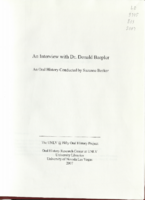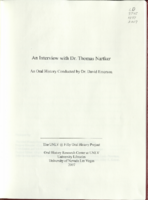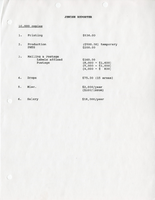Search the Special Collections and Archives Portal
Search Results

Interview with James Nobuo Yamazaki, October 14, 2005
Date
Archival Collection
Description
Text
Southern Nevada Historical Society Photograph Collection on Basic Magnesium, Inc.
Identifier
Abstract
The Southern Nevada Historical Society Photograph Collection on Basic Magnesium, Inc. contains photographs of the construction of Basic Magnesium Inc.'s plants and buildings from 1941 to 1942. The photographs primarily depict aerial views of the plant site and various buildings, including the administration building, tent camp, chlorination buildings, electrolysis facilities, electrical distribution systems, and warehouses. The photographs also depict Lake Mead and the early buildings in Henderson, Nevada.
Archival Collection

Transcript of interview with Gladys Neville by JoAnn Bingham, June 2, 2004
Date
Description
Text

Transcript of interview with Dr. Donald Baepler by Suzanne Becker, April 23, 2007
Date
Archival Collection
Description
Text

Transcript of interview with Dr. Thomas Nartker by Dr. David Emerson, November 13, 2006
Date
Archival Collection
Description
Text

Transcript of interview with Walter John Ritzau by Elizabeth Garrison, February 25, 1977
Date
Archival Collection
Description
On February 25, 1977, Walter John Ritzau interviewed Elizabeth Schneehagen Garrison (born 1943 in Las Vegas, Nevada) about her life in Southern Nevada. Garrison first talks about her schooling in Las Vegas and her first homes in Las Vegas. She also discusses the atomic testing, the Devils Hole in Ash Meadows, early church involvement, recreational activities, and some of the environmental aspects of Las Vegas. Garrison later describes her work for the Central Telephone Company before describing the Helldorado parade and some of the early activities designed for children. In the latter part of the interview, she describes her father’s garden, the changes in the city environment and building, shopping locations, and more about her home life.
Text
Marc Wilkinson Papers
Identifier
Abstract
The Marc Wilkinson Papers contain materials related to the business and personal life of Marc Wilkinson, his wife Theresa, and their printing business, Marc Wilkinson Printer located in Las Vegas, Nevada, from 1953 to 1980. The collection includes business correspondence, business advertisements, and materials relating to membership in Las Vegas social organizations.
Archival Collection
Miss Nevada U. S. A. Pageant Programs
Identifier
Abstract
The Miss Nevada U.S.A. Pageant Programs contain souvenir programs from the Miss Nevada U.S.A. Pageants held at the Holiday Casino in Las Vegas, Nevada from 1981 to 1985. These programs showcase the pageant contestants and feature advertisements from event sponsors. The collection also contains one souvenir program from the Miss Nevada Teen U.S.A. Pageant held in 1985.
Archival Collection
Alice Kinnear Photograph
Identifier
Abstract
The Alice Kinnear Photograph consists of one photographic print of the students and instructors at Las Vegas High School in Las Vegas, Nevada in 1916. An included document identifies the individuals in the photograph.
Archival Collection

